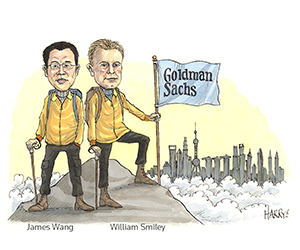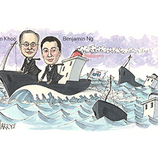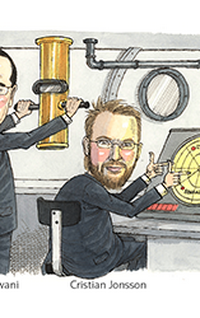Leading the way
In a year full of regulatory uncertainty for Asia’s equity capital markets, one bank captured the key market themes and responded quickly to changes so that it could raise funds for its clients. For leading the most important deals for the year, Goldman Sachs is IFR Asia’s Equity House and Structured Equity House of the Year.
![]()
Goldman Sachs led the way in Asia’s equity capital markets in 2021, securing key roles on the biggest capital raisings of the year and showing its strength across a broad mix of markets and products.
Amid a frenzy over technology companies because of their rapid growth during the Covid-19 pandemic, Asia saw global banner transactions in the first half. Sentiment turned in July after Chinese regulators stepped up scrutiny of the country’s tech giants, but record issuance continued in other markets such as South Korea, Australia and India.
“As a team, we have been able to identify where the opportunities lie, [such] that we have seen a breakout and a complete rerating of our business last year,” said Iain Drayton, co-head of investment banking in Asia ex-Japan at Goldman.
Equity and equity-linked fundraising in Asia-Pacific, ex-Japan, rose 21% in 2021 to an all-time high of US$501bn. Goldman picked up US$35.3bn of league table credit through 107 transactions with a market share of 7.1%, according to Refinitiv data.
“We led the landmark transactions and our breadth is across products, markets and sectors,” said William Smiley, co-head of equity capital markets for Asia ex-Japan until January 2022 (he has since moved to the global markets division as head of ECM public distribution for Asia-Pacific).
The US investment bank led seven out of the 10 biggest equity raisings last year, including the US$14.7bn sell-down in Chinese internet giant Tencent Holdings by Prosus, the biggest block trade in Asia, and a mammoth US$10bn equity combo (US$7bn primary follow-on, US$3bn convertible bond) from Chinese online delivery outfit Meituan.
Apart from leading the tech space, Goldman also dominated the healthcare sector after years of hard work building up its franchise. The bank was in the driving seat for most Hong Kong healthcare IPOs last year, helping 12 issuers raise a combined US$4.2bn.
“2021 is a showcase to demonstrate our leadership in market themes. We led all the market themes that define the future of the markets in the next few years including TMT, healthcare and homecoming listings,” said James Wang, co-head of ECM for Asia ex-Japan.
While China-to-US listings are off-limits amid escalating political tension between the two superpowers, Goldman focused its resources to bring US-listed Chinese companies back to Hong Kong. It sponsored seven homecoming listings, the most among all banks, including the HK$24bn (US$3.1bn) float of search engine giant Baidu, the US$3bn deal for video-streaming site Bilibili and the US$1.7bn offering of electric vehicle maker Li Auto.
Goldman’s breadth of business was impressive, but it was its geographic diversity that mitigated regulatory headwinds and differentiated it from its competitors.
“Regardless of the prevailing investor sentiment and any sort of cross-border tension, there will continue to be activity and we position ourselves to anticipate where that activity is going to be and to be part of it,” said Drayton.
Expecting that local exchanges will get even busier, Goldman, which currently has slightly over 300 bankers across Asia-Pacific ex-Japan in investment banking, is on a hiring spree and plans to grow headcount outside China in particular.
During the awards period, Goldman led important deals from South Korea, which was the most active market after China in 2021 in terms of ECM volume. The bank was the lead-left bookrunner on South Korean e-tailer Coupang’s US$4.55bn NYSE IPO and it also led the US$1.3bn Korea Exchange IPO of Ant-backed online payment provider Kakao Pay. Shares of both companies doubled on their debuts.
Australia provided other highlights, including the A$6.3bn (US$4.5bn) deal of biotechnology company CSL, the largest-ever primary follow-on in the country. Goldman demonstrated its risk appetite for the right clients, hard underwriting the trade with another bank even though it came in December – traditionally not a usual window for mega transactions as investors tend not to take additional risk at year-end.
Playing into its strength in tech, it also helped Australian buy-now-pay-later company Afterpay raise A$1.5bn from an upsized convertible bond in the country’s largest CB issue. The deal was priced at a 45% conversion premium, the highest for an Australian issuer.
In India, Goldman was a joint global coordinator in the country’s largest IPO – the Rs183bn (US$2.47bn) float of payments company Paytm, officially named One 97 Communications.
SIGNATURE DEAL
The signature deal that demonstrated Goldman’s unmatched strength in tech and ability to seize market windows was undoubtedly the US$6.9bn equity combo of Singapore-headquartered, NYSE-listed e-commerce giant Sea.
Listed in 2017, Sea is a regular in the ECM market. Before the combo, the company had already done six capital markets transactions of US$1bn–$3bn. Goldman, which was lead-left bookrunner on all the previous deals, retained its position on the seventh – the biggest of all.
The deal hit the market in September when investors had turned their back on Chinese tech deals because of potential regulatory risks and were keen to seek high-growth alternatives in the region. The Sea offering immediately drew huge attention from investors, allowing it to raise US$4bn from a primary follow-on and US$2.9bn from a convertible bond in South-East Asia’s biggest equity-related offering.
The deal also showed the US market was wide open for the right South-East Asian companies, encouraging more unicorns from the region to consider listing there.
The Sea and Meituan trades highlighted Goldman’s remarkable dominance in the equity-linked market. The former was the largest CB in 2021 in the US while the latter was the largest-ever CB in Asia-Pacific.
International equity-linked issuance from Asia-Pacific ex-Japan reached a record US$23.8bn in 2021, according to Refinitiv data. Goldman continued to be at the forefront of the wave of issuance with a dominant position across large transactions and key markets. It topped the league table with a 21% market share, raising US$4.99bn from 11 transactions.
“In every single one of these trades, we focused on being the lead bank on restructuring, driving, advising, and getting trades across the line,” said Christian Lhert, head of equity-linked origination for Asia-Pacific ex-Japan.
The bank harnessed the upbeat sentiment surrounding ESG themes and acted as the sole sustainability structuring adviser for Bilibili’s US$1.6bn green CB. The largest ever green CB from a Chinese issuer attracted strong demand from European long-only investors that have ESG mandates.
The November deal also reopened the Chinese ADR equity-linked market seven months after the Li Auto CB, against the backdrop of a fast-evolving regulatory landscape for Chinese tech companies.
While offshore China deals almost came to a halt in the second half, Goldman, which won approval in October to take full ownership of its China securities joint venture Goldman Sachs Gao Hua Securities, used its domestic platform to continue to print sizeable deals for clients.
Just as in the overseas market, Goldman was not shy to commit its own capital. As sponsor, it invested Rmb433m in BeiGene’s Shanghai Star listing as required by China’s regulations, becoming the first US bank to co-invest in a Star IPO. The Hong Kong and US-listed cancer-focused biotech company raised Rmb22.2bn (US$3.5bn) from the largest IPO on the Nasdaq-style board in the year.
Goldman was also one of the bookrunners for express delivery and logistics service provider Shenzhen-listed SF Holding’s Rmb20bn private share placement in October.
This range made Goldman the top choice for issuers looking to push the limits of the Asian equity market, and kept it busy even as some funding avenues closed during the year.
To see the digital version of this report, please click here
To purchase printed copies or a PDF, please email gloria.balbastro@lseg.com













